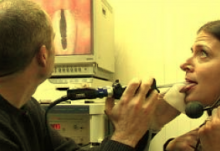If you are hoarse, almost certainly you will benefit from a video recording of your vocal cords. Most vocal events happen too fast for you to perceive, without some capability to slow and review the images of a video recording. Even video needs some help from a stroboscope or high-speed recording to catch events well.
A rigid endoscope is passed through the mouth to visualize the vocal cords. It is difficult to say much of anything other than “eeeeee” while the examiner holds your tongue, but it does provide a very clear picture of the vocal cords. Most people need some topical anesthesia in order to keep from gagging during this examination.
Alternatively, a flexible endoscope is passed through the nose. At the back of the nose, it is angled downward to view the vocal cords.
If you are able to view a video of your vocal cords moving, along with the framework described in my book and here in my blog for understanding normal and abnormal voice, you might be able to identify the probable location of your hoarseness. At a minimum, you should be able to estimate whether or not your physician was directing you in an appropriate direction.
Hoarseness can be visualized and with a few guidelines can be understood. My book, “Why is There a Frog in My Throat: A Guide to Hoarseness” will provide a framework for that understanding.

